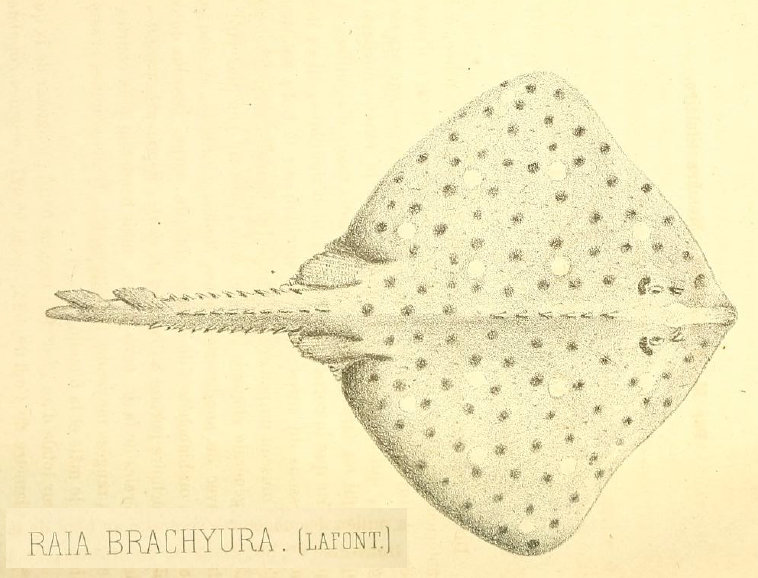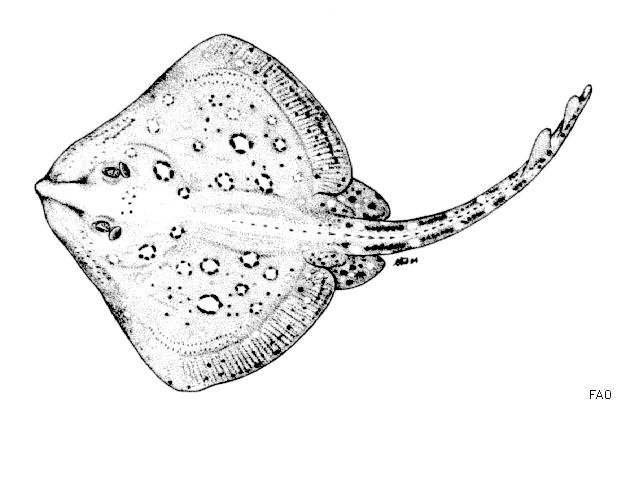Raja brachyura
Lafont, 1873
Blonde ray
Classification: Elasmobranchii Rajiformes Rajidae
Reference of the original description
Description d'une nouvelle espèce de raie. Actes de la Société linnéenne de Bordeaux, 28, 503–504
Description d'une nouvelle espèce de raie. Actes de la Société linnéenne de Bordeaux, 28, 503–504
Image of the original description

Raja brachyura Lafont, 1873

Raja brachyura Lafont, 1873
Synonyms / new combinations and misspellings
Raia blanda, Raia brachyura, Raja blanda, Raja (Raja) brachyura
Raia blanda, Raia brachyura, Raja blanda, Raja (Raja) brachyura
Description :
Citation: Raja brachyura Lafont, 1873: In: Database of modern sharks, rays and chimaeras, www.shark-references.com, World Wide Web electronic publication, Version 05/2025
Please send your images of "Raja brachyura" to info@shark-references.com

Raja brachyura Lafont, 1873, © FAO, www.fish-base.org

Raja brachyura Lafont, 1873, © FAO, www.fish-base.org
Common names
 Blonde,
Blonde,  Blondrochen,
Blondrochen,  Boca de rosa,
Boca de rosa,  Raia braquiura,
Raia braquiura,  Raya,
Raya,  Raya boca de rosa,
Raya boca de rosa,  Raya braquiura,
Raya braquiura,  Raie blanche,
Raie blanche,  Raie blanche douce,
Raie blanche douce,  Raie blanche lissée,
Raie blanche lissée,  Raie lisse,
Raie lisse,  Blonde,
Blonde,  Blonde ray,
Blonde ray,  Blonde skate,
Blonde skate,  Pichira schizzata,
Pichira schizzata,  Razza a coda corta,
Razza a coda corta,  Arraia,
Arraia,  Raia,
Raia,  Raia pontuada,
Raia pontuada,  Raia-pontuada
Raia-pontuada
 Blonde,
Blonde,  Blondrochen,
Blondrochen,  Boca de rosa,
Boca de rosa,  Raia braquiura,
Raia braquiura,  Raya,
Raya,  Raya boca de rosa,
Raya boca de rosa,  Raya braquiura,
Raya braquiura,  Raie blanche,
Raie blanche,  Raie blanche douce,
Raie blanche douce,  Raie blanche lissée,
Raie blanche lissée,  Raie lisse,
Raie lisse,  Blonde,
Blonde,  Blonde ray,
Blonde ray,  Blonde skate,
Blonde skate,  Pichira schizzata,
Pichira schizzata,  Razza a coda corta,
Razza a coda corta,  Arraia,
Arraia,  Raia,
Raia,  Raia pontuada,
Raia pontuada,  Raia-pontuada
Raia-pontuada
Short Description
Upper surface wholly prickly, except in juveniles; underside only prickly along front margins of disc; orbital thorns separate; a regular median row of 40-45 thorns in juveniles and adult females, interrupted on back in males; 60-90 tooth rows; upper surface ochre, with numerous small dark spots to margins of disc, underside white [7182].
Upper surface wholly prickly, except in juveniles; underside only prickly along front margins of disc; orbital thorns separate; a regular median row of 40-45 thorns in juveniles and adult females, interrupted on back in males; 60-90 tooth rows; upper surface ochre, with numerous small dark spots to margins of disc, underside white [7182].
Distribution
Eastern Atlantic: Shetland Islands to Morocco, Rio de Oro (Western Sahara), and Madeira. Source: www.gbif.org
Eastern Atlantic: Shetland Islands to Morocco, Rio de Oro (Western Sahara), and Madeira. Source: www.gbif.org
Human uses
fisheries: minor commercial; gamefish: yes; price category: medium; price reliability: questionable: based on ex-vessel price for species in this genus
fisheries: minor commercial; gamefish: yes; price category: medium; price reliability: questionable: based on ex-vessel price for species in this genus
Biology
Oviparous, paired eggs are laid. Embryos feed solely on yolk [733]. Spawning mainly from February to August with at least 30 egg-cases laid [7182]. Distinct pairing with embrace. Young may tend to follow large objects, such as their mother [17086].
Oviparous, paired eggs are laid. Embryos feed solely on yolk [733]. Spawning mainly from February to August with at least 30 egg-cases laid [7182]. Distinct pairing with embrace. Young may tend to follow large objects, such as their mother [17086].
Size / Weight / Age
120 cm TL (male/unsexed; (Ref. 41333)); 125 cm TL (female); max. published weight: 14.3 kg (Ref. 40637); Sardinian Sea (data base: 839 specimens collected between 2005-2009): females (N=408) ranged between 131 and 1055 mm, while the males (N=431) between 156 and 965 mm TL [17741]
120 cm TL (male/unsexed; (Ref. 41333)); 125 cm TL (female); max. published weight: 14.3 kg (Ref. 40637); Sardinian Sea (data base: 839 specimens collected between 2005-2009): females (N=408) ranged between 131 and 1055 mm, while the males (N=431) between 156 and 965 mm TL [17741]
Remarks
shark-references Species-ID=5548;
shark-references Species-ID=5548;
Parasites (arranged by Jürgen Pollerspöck)
Kinetoplastea
Monogenea
Cestoda
Nematoda
Copepoda
Kinetoplastea
- Trypanosoma giganteum Neumann, 1909 [21437]
Monogenea
- Acanthocotyle lobianchi Monticelli, 1888 [15270] [15273]
- Acanthocotyle sp. [9086]
- Calicotyle kroyeri Diesing, 1850 [15273] [15268] [17436] [9086]
- Dictyocotyle coeliaca Nybelin, 1941 [23943]
- Empruthotrema raiae (Maccallum, 1916) Johnston & Tiegs, 1922 [15273] [17002] [9086]
- Hexabothrium appendiculatum (Kuhn, 1829) [19885]
- Rajonchocotyle blandae Sproston, 1946 [17150]
- Rajonchocotyle emarginata (Olsson, 1876) [15273] [15243] [17450] [9086]
Cestoda
- Acanthobothrium benedeni (Lönnberg, 1889) [16175] [16448]
- Acanthobothrium dujardinii Van Beneden, 1849 [16247] [16175] [16448] [28741]
- Acanthobothrium filicolle (Zschokke, 1887) [16448]
- Acanthobothrium sp. [16448] [9086]
- Anthobothrium auriculatum (Rudolphi, 1819) [19885]
- Crossobothrium sp. [9086]
- Echeneibothrium sp. [9086]
- Echinobothrium brachysoma Pintner, 1889 [9086]
- Grillotia erinaceus (Van Beneden, 1858) [16112] [9086] [7411] [33185]
- Grillotia sp. [9086]
- Nybelinia lingualis (Cuvier, 1817) [9086]
- Phyllobothrium lactuca Van Beneden, 1850 [9086]
- Phyllobothrium thridax (Van Beneden, 1849) [16443] [16443]
Nematoda
- Anisakis simplex (Rudolphi, 1809) [9086] [33185]
- Hysterothylacium sp. [9086]
- Metanisakis baylisi (Gibson, 1973) [9086]
- Piscicapillaria (Piscicapillaria) freemani (Moravec, Margolis & Mcdonald, 1981) [9086]
- Proleptus sp. [9086] [33185]
Copepoda















